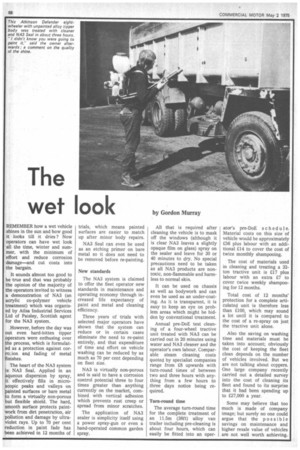The wet ook
Page 70

If you've noticed an error in this article please click here to report it so we can fix it.
by Gordon Murray
REMEMBER how a wet vehicle shines in the sun and bow good it looks till it dries ? Now operators can have wet look all the time, winter and summer, with the minimum of effort and reduce corrosion damage—and cut costs into the bargain.
It sounds almost too good to be true and that was probably the opinion of the majority of the operators invited to witness a demonstration of NA3 (an acrylic co-polymer vehicle treatment) which was organised by Miss Industrial Services Ltd of Paisley, Scottish agent for the NA3 system.
However, before the day was out even hard-bitten tipper operators were enthusing over the process, which is formulated as a protection against corro:.ion and fading of metal finishes.
The heart of the NA3 system is NA3 Seal. Applied in an aqueous dispersion by spray, it effectively fills in microscopic peaks and valleys on painted surfaces or bare metal to form a virtually non-porous but flexible shield. The hard, smooth surface protects paintwork from dirt penetration, air pollution and damage by ultraviolet rays. Up to 70 per cent reduction in paint fade has been achieved in 12 months of trials, which means painted surfaces are easier to match up after minor body repairs.
NA3 Seal can even be used as an etching primer on bare metal so it does not need to be removed before re-painting.
New standards The NA3 system is claimed to offer the fleet operator new standards in maintenance and operating economy through increased life expectancy of paint and metal and cleaning efficiency.
Three years of trials with selected major operators have shown that the system can reduce or in certain cases eliminate the need to re-paint entirely, and that expenditure of time and effort on vehicle washing can be reduced by as much as 70 per cent depending on fleet size.
NA3 is virtually non-porous and is said to have a corrosion control potential three to four times greater than anything currently on the market, combined with vertical adhesion which prevents rust creep or spread from minor scratches.
The application of NA3 sealer is simplicity itself using a power spray-gun or even a hand-operated common garden spray. All that is required after cleaning the vehicle is to mask off the windows (although it is clear NA3 leaves a slightly opaque film on glass) spray on the sealer and leave for 30 or 40 minutes to dry. No special precautions need to be taken as all NA3 products are nontoxic, non-flammable and harmless to normal skin.
It can be used on chassis as well as bodywork and can even be used as an under-coating. As it is transparent, it is easy to keep an eye on problem areas which might be hidden by conventional treatment.
Annual pre-DoE test cleaning of a four-wheel tractive unit treated with NA3 can be carried out in 20 minutes using water and NA3 cleaner and the operator's own labour. Comparable steam cleaning costs quoted by specialist companies range from E8 upwards with turn-round times of between two and three hours with anything from a few hours to , three days notice being required.
Turn-round time The average turn-round time for the comPlete treatment of an 11.5m (38ft) alloy van trailer including pre-cleaning is about four hours, which can easily be fitted into •an oper ator's pre-DoE schedule. Material costs on this size of vehicle would be approximately £56 plus labour with an additional £14 to cover the cost of twice monthly shampooing.
The cost of materials used in cleaning and treating a 32ton tractive unit is £17 plus labour With an extra £7 to cover twice weekly shampooing for 12 months.
Total cost of 12 months' protection for a complete articulated unit is therefore less than £100, which may sound a lot until it is compared to the cost of a re-spray on just the tractive unit alone.
Also the saving on washing time and materials must be taken into account; obviously the cost of keeping the fleet clean depends on the number of vehicles involved. But we are not talking about coppers. One large company recently carried out a detailed survey into the cost of cleaning its fleet and found to its surprise that it had been spending up to £27,000 a year.
Some may believe that too much is made of company image; but surely no one could argue that the possible savings on maintenance and higher resale value of vehicles are not well worth achieving.
























































































































